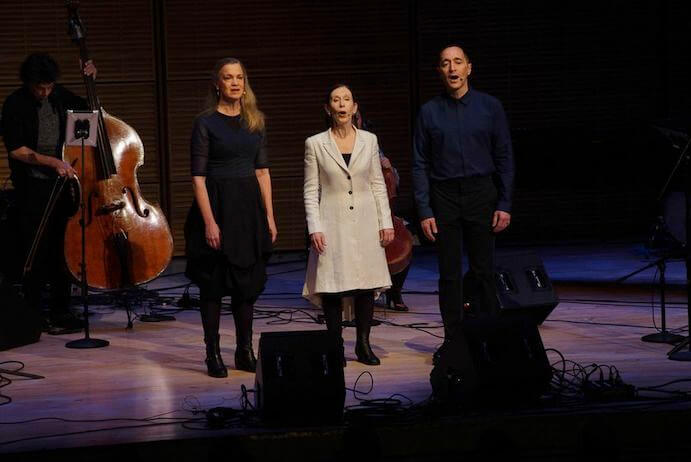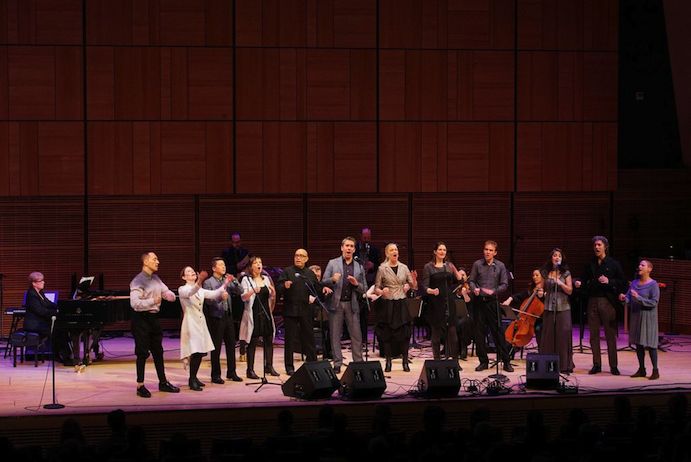I thought I had had my fill of surprises that day, but about halfway through the Meredith Monk & Friends celebration at Carnegie’s Zankel Hall on March 22, percussionist Cyro Baptista marched out, booming on a bass drum, with John Zorn not far behind, wailing on his saxophone. The two musicians roamed around the stage in seemingly haphazard trails, creating quite the ruckus before unceremoniously marching back out. They had offered their interpretation of Monk’s Dungeon (1970), a vocal work featured on her debut album Key: one of many reinterpretations and arrangements on the four-and-a-half-hour all-Monk program, which highlighted not only Monk’s range in artistic voice but also the sheer number of performers and “friends” of her music layering in their own voices. The exhilarating and unpredictable maze of sound contrasted with DJ Spooky’s remix of selections from Book of Days (1988), during which he had stood nearly motionless on the stage, calmly maneuvering his iPad, which filled the hall with ethereal prerecorded sounds. Meanwhile Rigdzin Pema Collins sent soaring violin loops and melodies into the atmosphere in the two musicians’ rendering of Monk’s work. Yet during his on-stage interview with host John Schaefer, DJ Spooky acknowledged that Meredith Monk is “a pioneer for the voice in space,” and mentioned Satie’s Musique d’ameublement (“Furniture Music”) as a corollary and influence, stating that she builds “cathedrals of voices” even while making time and boundaries slip away.

Meredith Monk and Friends– Photo by Boyd Hagen
The importance of architectural space was evident from the very first work on the program, Monk’s work in progress Cellular Songs, during which the vocalists turned towards the audience, towards each other, and then back towards the audience. Don Byron’s arrangement for clarinet quartet of Click Song no. 1 could not begin until the four clarinetists had adjusted their chairs, silently situated themselves spatially before they began their piece, which ranged from clicking fingerpads to percussive tonguing to vocal growls to a piercing final solo. Musicians were constantly sitting down, standing up: their footsteps pattering across the stage in choreographed trails, their arms and legs and faces turned now towards each other, now towards the piano, now towards the audience. The Bang on a Can All-Stars shuffled the vibraphone around in between their co-founders’ arrangements of Monk songs; the Meredith Monk Vocal Ensemble oriented themselves across the stage in new ways throughout their astonishingly-sung selections from ATLAS and Songs of Ascension.
Perhaps most shocking of all in its exploration of space was the world première of Lee Ranaldo’s arrangement of Astronaut Anthem. On the darkened stage, the Sonic Youth co-founder strummed and struck his electric guitar with mallets, drew circles of scraping metallic sounds with the guitar’s neck as he dragged it across the floor, and waved his guitar around a speaker, which seemed to create a forcefield of jaw-droppingly loud vibrations emanating from both the speaker and the guitar. At times Ranaldo simply wandered through these distortions and reverberations, while at others he seemed focused on orchestrating every aspect of the lunacy, before finally pausing to strum the final note. During his own conversation with Schaefer, Ranaldo expressed discontent with the derogatory connotations of the word “noise,” choosing instead to focus on the different colorations of what noise can be and mean, and to praise Monk’s use of sound and of language and non-language.

Meredith Monk and Friends– Photo by Boyd Hagen
Ranaldo wasn’t the only performer on the program to use instruments in unconventional ways; during Todd Reynolds’s arrangement of Monk’s Gotham Lullaby (1975), John Hollenbeck’s percussion phrases were unusually metallic, like keys jangling or a slinky unfolding, as he scrambled around manipulating various oddities. And during Lukas Ligeti’s reimagining of Shadow Song, his mallets hammered out patterns on his marimba lumina (a type of MIDI controller) that resulted not in the expected percussive pings but in prerecorded voices and repeated modules of digital and acoustic textures, all of which mingled in drapes and folds across the soundscape. These musicians worked not within the unpredictable “boundarylessness” (Schaefer’s coined term) of Monk’s non-language and nonsense words, but within her world of expanded performance space. Transcribing her vocal works for their own devices, the composers and performers, ranging from Missy Mazzoli to Lukas Ligeti to Theo Bleckmann to John Zorn, were able to map out their own territories within the unique worlds that Monk’s music creates. And of course to round things out, there was the final return to the familiar world of Panda Chant II as the entire roster of performers filed onto the stage, swayed back and forth, stamped their feet and clapped their hands, and drew us into this most buoyant of spaces, with Meredith Monk herself front and center.






















